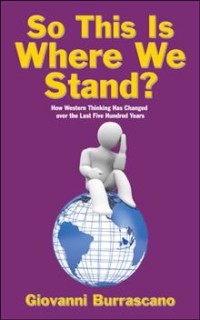Title: So This Is Where We Stand? How Western Thinking Has Changed over the Last Five Hundred Years
Author: Giovanni Burrascano
Publisher: iUniverse
ISBN: 978-1-5320-0229-8
Pages: 192
Genre: Nonfiction / Social Science / Developing & Emerging Countries
Reviewed by: J.W. Bankston
Buy Book on AmazonPacific Book Review
As a 14-year old, Giovanni Burrascano asked his father a question, “Why is the world the way it is?” Over 40 years later, Burrascano attempts to answer his own question with, “So This Is Where We Stand? How Western Thinking Has Changed over the Last Five Hundred Years.” In this short volume, he attempts to apply General Systems Theory to a simple question with a very complex answer. After all, asking “why is the world the way it is” is akin to asking “what is the meaning of life?” Rest assured, the answer is not hot apple pie.
The book is hard to categorize. It is as much philosophy and the author’s point of view as it is science and history. This is understandable as Burrascano is a self-styled Renaissance man, a polymath with a science background who has worked in commercial real estate. The author, who earned an undergraduate degree in geography at Montreal’s prestigious McGill University, notes that, “Geography is the only academic discipline that seeks understanding of the interaction between humans and the physical world.” To Burrascano, the world is losing –– badly.
With the opening chapters he does a nice job re-introducing the reader to many of the people and events most of us first learned about in elementary school. There are the great scientific thinkers of the last half-millennia –– Galileo, Darwin, Newton, and Descartes among them. As he summarizes their achievements, the writer opines that many of their conclusions were not driven by science but by cultural biases. The background of these learned men was one reason that Darwin, for example, believed in the survival of the fittest. This carries on with his assessment of the Industrial Revolution and its impacts. He even connects survival of the fittest to capitalism. Although he loses points with me by quoting Lenin, he gains them by excoriating the cult of John Maynard Keynes. Burrascano also believes that a relentless focus on growth inevitably leads to overconsumption of resources and overpopulation.
Reading this book, I was reminded of Jared Diamond’s “Guns, Germs and Steel.” Like Burrascano, Diamond has a background in geography and applies a trans-disciplinary approach to the question of Western dominance over the past 500 years. As with this book, Diamond’s work also gives little credit to Western societies for innovation in either technology or economic systems. Instead Diamond postulates that geographic good fortune was a dominant factor. Burrascano points more simply to Western exploitation saying, “European colonialism created third world under development and continues to perpetuate it in the countries of Latin America, Africa and Asia.” Thus at the midpoint, the author commences a survey of various colonized countries, particularly in Latin America, along with exploited cultures. Following this, he attributes the ills of both emerging nations and the environment to capitalism.
The view that the profit motive is primarily responsible for the destruction of both the planet and many of the world’s less fortunate people is not a new one. Indeed, the author acknowledges that he is not providing earth shattering information. There is also a counter argument that even in the poorest of countries, the adoption of market economies has greatly improved living conditions. The middle classes of China are a prime example –– people that a few generations ago were starving can now afford air conditioning and new automobiles. Fundamentally, even in emerging nations, the spread of many deadly diseases has been curtailed. As Ayn Rand said, “Capitalism did not create poverty— it inherited it.” Still, regardless of one’s point of view, the writer does a fine job of assembling evidence and laying out his arguments. The book succeeds as a rallying cry for those concerned about human impacts on the environment. It is easy then to recommend this book to anyone already predisposed to its charms, for within its pages there are many.



Follow Us